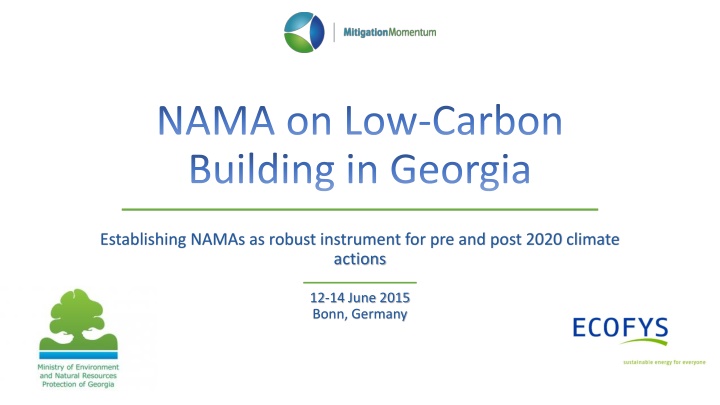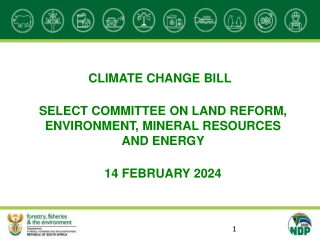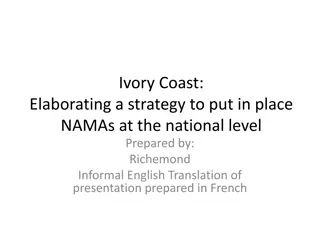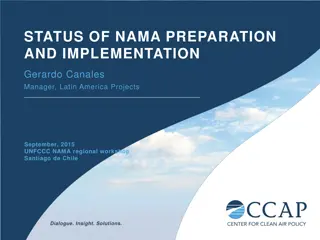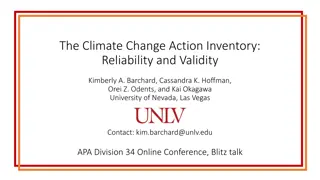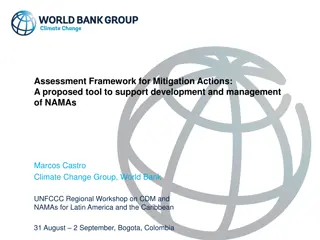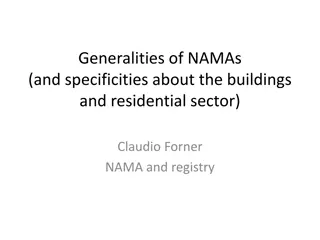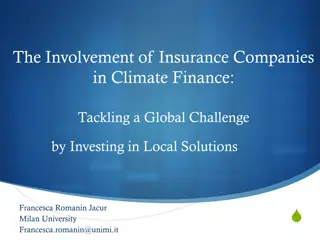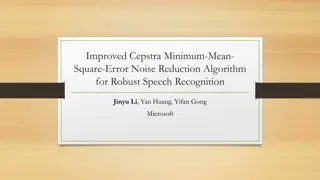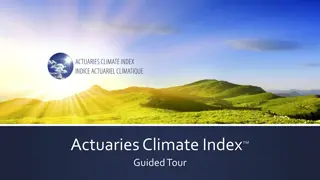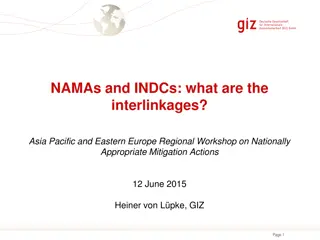Establishing NAMAs as Robust Instrument for Climate Actions
Vision, goals, and objectives of a NAMA on low-carbon building in Georgia, focusing on energy efficiency, financial aspects, national policy context, and outcomes to reduce emissions and improve accessibility to low-carbon construction. It includes strategies for coordination, market mechanisms, and achieving emission reduction targets.
Download Presentation

Please find below an Image/Link to download the presentation.
The content on the website is provided AS IS for your information and personal use only. It may not be sold, licensed, or shared on other websites without obtaining consent from the author.If you encounter any issues during the download, it is possible that the publisher has removed the file from their server.
You are allowed to download the files provided on this website for personal or commercial use, subject to the condition that they are used lawfully. All files are the property of their respective owners.
The content on the website is provided AS IS for your information and personal use only. It may not be sold, licensed, or shared on other websites without obtaining consent from the author.
E N D
Presentation Transcript
NAMA on Low-Carbon Building in Georgia Establishing NAMAs as robust instrument for pre and post 2020 climate actions 12-14 June 2015 Bonn, Germany
CONTENT CONTENT Vision, Goals and Objectives Intended outputs/outcomes Institutional arrangement and time frames NAMA DESCRIPTION National development strategy/plans National policy framework Financial flow into low-carbon investments NATIONAL POLICY CONTEXT A full cost of implementation Financial investment plan Financial risks and barrier analysis FINANCIAL ASPECTS
NAMA VISION NAMA VISION To support a coordinated approach to the development of low-carbon building sector which includes planning and refurbishment within the city with active stakeholder participation focusing on energy efficiency and energy savings related to building standards meeting and GHG mitigation.
N A M A G O A L To develop low emission public-building sector through the piloting of new market mechanism such as ESCO, with upscaling incentive to the residential sector. NAMA OBJECTIVES Improve the Energy Efficiency Develop options for building-integrated and small scale renewables The development and transformation of the national market Improve finance accessibility for low carbon building construction Contribution in the Covenant of Mayors and LEDS implementation processes
NAMA OUTCOME 25 per cent emissions reduction from public-building sector through the refurbishment of state-owned buildings are achieved during the first phase. NAMA OUTPUTS 1.1 *106 m2 has been renovated The preparatory work for upscaling has been conducted ESCO market model has launched The finance accessibility for low carbon building construction has improved The CoM commitments are met and LEDS action plan is under implementation
NATIONAL/LOCAL DEVELOPMENT STRATEGY NATIONAL/LOCAL DEVELOPMENT STRATEGY Coordination between LEDS building sector committee and NAMA developers LEDS Implementation of BAU deviation scenario NAMA on Low-Carbon Building CoM Support in SEAP implementation Municipal buildings refurbishment Enhancement of local level capacity
NATIONAL POLICY FRAMEWORK NATIONAL POLICY FRAMEWORK Directive 2010/31/EU on the energy performance of buildings Directive 2006/32/EC on energy end-use efficiency and energy services Directive 2010/30/EU on the indication by labelling and standard product information EU Association Agreement Georgia s building sector NAMA aims to support this process and to break down the existing barriers towards achieving low carbon buildings. Thereby linking directly to national policy priorities. A timeline to the Association Council June 2016 Accession to the Energy Community Treaty June 2014 2017 Retraining constructions of the building and its orientation as well as equipment and devices for heating, air conditioning, lighting, ventilation and thermal insulation shall be maximally energy-efficient. Energy-efficiency standards for buildings are determined by the decree of the Government of Georgia on Energy-efficiency of Buildings. Laws regulating the energy-efficiency issues shall take into consideration European and international best practice. National Legal Arrangement
INSTITUTIONAL ARRANGEMENT INSTITUTIONAL ARRANGEMENT Ministry of Economy Ministry of Finance Ministry of Energy Ministry of Environment NEEAP developer The CoM coordinator Provision of funds from central budget National loans acceptor Legislation on EE in buildings EU AA on EE in buildings Constructions market labeling EBRD Project Implementer MRV system coordinator The CoM coordinator Access to finance for municipalities City Hall 1 City Hall 3 CoM City Hall 2 ESCO Residential buildings Public buildings lack of building standards for low carbon refurbishment Lack of legal status for cooperation in multi-occupancy buildings Additional cost of low carbon refurbishment
FINANCIAL ASPECTS OF NAMA FINANCIAL ASPECTS OF NAMA The option of CommunityESCOs which do not aim for profits, but reinvest in local economy or energy systems could be a promising option for Georgia as well; currently found in UK and Hungary, as well as on a city level (e. g. Berlin) These type of ESCOs are more suitable to support the achievement of sustainable development as well as climate goals. Within the EU ESCO market also Third-party financing (TPF) is common, where a finance institution provides project financing instead of the customer or the ESCO doing this This is especially interesting for Georgia, as in the beginning phase external/international funding support would be needed to kick start the market Another way donor funding can support ESCO projects is by providing guarantees as a next step to initial grant type funding
TIMEFRAME TIMEFRAME EU AA Energy Community Treaty NATIONAL LEGISLATION EBRD PROJECT NEEAP IMPLEMENTATION NAMA PROPOSAL 2015 2016 2017 2020 PHASE I ESCO model for public buildings in the covenant cities PHASE II Extend to the residential sector in urban areas
Co-Benefits Economic The cost savings against a business as usual scenario New job opportunities The increase in asset values Energy Security Reducing of the Energy dependence Reducing of the energy intensity Social & Health Decline the events of cardio-vascular and respiratory diseases Decrease the events of more minor illnesses A positive impact on mental well-being Environment Reduction of Natural Gas usage Reduction of demand on firewood
NAMA on Low-Carbon Building in Georgia Thank you!
